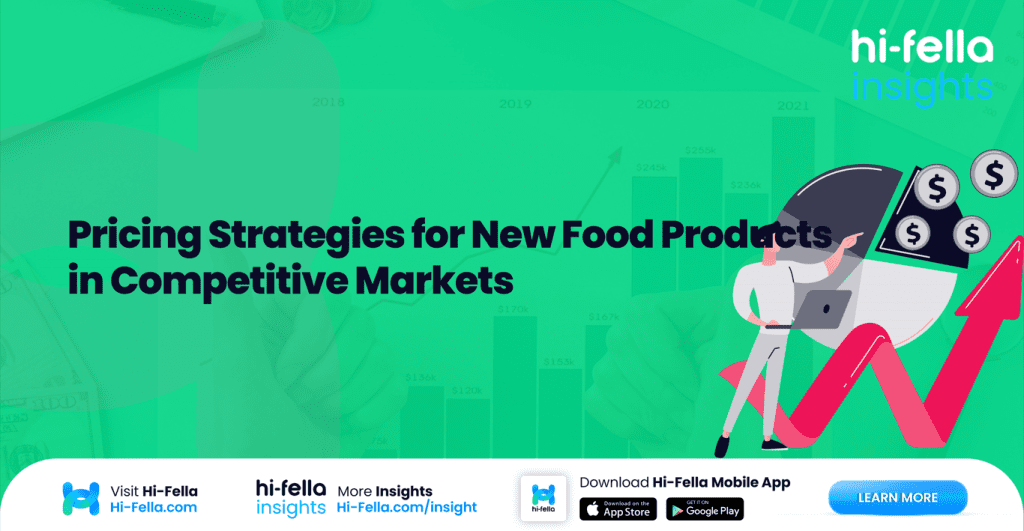You’ve got a great new food product—maybe it’s a spicy cassava chip, a plant-based protein bar, or a ready-to-drink mushroom latte. The recipe’s nailed down, the packaging pops, and retailers are curious. But here comes the big question: what’s the price?
In a competitive market, pricing isn’t just a number—it’s a signal. It tells consumers where your product sits on the value spectrum. It shapes buyer expectations. And it can make or break your ability to scale.
Let’s explore the smartest pricing strategies for new food products—and how to use pricing not just to survive, but to stand out.
Understand the Market Landscape Before You Tag It
Before setting any price, the first move is to understand the landscape you’re stepping into. Pricing isn’t done in a vacuum—it’s shaped by the category you’re entering, the behaviours of your competitors, and the expectations of your target customers. If you skip this part, you risk setting a price that either undervalues your product or pushes you out of contention altogether. So the golden rule is simple: study the market before you tag it.
Start by researching the current pricing norms in your product category. What’s the average retail price for similar items? Are there big gaps between low-end and premium players? Take note of how these prices shift across different regions or export markets. A snack that sells for RM5 in Malaysia might go for USD3.50 in the US—so understanding price elasticity and regional positioning is crucial if you’re planning to scale beyond domestic borders.
Next, ask yourself: is this a commoditised product or a category that thrives on innovation? Commoditised categories—like bottled water, table salt, or white rice—often compete on price and availability, leaving less room for brand storytelling or premium positioning. On the flip side, if you’re launching something newer or trend-driven—like functional beverages, plant-based protein, or gut-health snacks—you’ll find more pricing freedom. Innovation allows you to justify higher prices, especially if your value proposition resonates with early adopters or health-conscious consumers.
Understanding your competition is another essential layer. Who else is selling something similar, and how are they presenting it? Are they going for a clean, premium feel with minimalist packaging, or leaning into affordability with bright, value-focused branding? Analysing their branding, price points, and distribution channels will tell you where they’re positioned—and where you might fit in, or stand out. The goal isn’t to copy them, but to find your lane within the competitive grid.
Ultimately, pricing is about perception. You’re not just assigning a value to your product—you’re shaping how the market experiences it. A slightly higher price might signal superior quality or exclusivity, while a lower one could imply accessibility or mass-market appeal. Both can work, but only if they align with your product’s identity and your target audience’s mindset. So before you decide how much to charge, take the time to understand how your product will be seen—not just how much it costs to make. That’s how you price with strategy, not guesswork.
Cost-Plus Pricing: A Basic Starting Point, Not a Strategy
Let’s start with the classic: cost-plus pricing. You calculate your unit cost—raw materials, packaging, labour, distribution—and add a markup. Sounds logical, right?
Yes, but in competitive markets, this method falls short. It ignores customer value, brand perception, and pricing psychology. If your cost is $1.20 and you mark it up 50%, you get $1.80. But what if consumers would happily pay $2.50 based on brand experience or convenience?
Cost-plus should be your floor, not your ceiling.
Value-Based Pricing: Charge What It’s Worth, Not What It Costs
Value-based pricing is about aligning your price with what your customer believes it’s worth. That might include:
- Health or dietary benefits (e.g., gluten-free, keto, non-GMO)
- Ethical sourcing or sustainability credentials
- Brand prestige or lifestyle fit
- Convenience or ready-to-eat appeal
Let’s say you’re launching a high-protein, plant-based jerky. If your target consumer is a gym-going urban millennial who cares about macros and clean labels, they’re not comparing you to gas station beef jerky—they’re comparing you to $3 protein bars. Price accordingly.
Value-based pricing lets you capture margin by anchoring your product to meaning, not just ingredients.
Penetration Pricing: Enter Boldly, Then Adjust
If you’re entering a crowded market with aggressive competitors, penetration pricing might be your inroad. This strategy involves launching at a lower price to quickly gain market share, boost trial, and attract attention.
But here’s the key: make it time-bound and strategic. Don’t train your customers to expect low prices forever. Once your product is established, gradually increase the price or introduce premium SKUs.
Penetration pricing is a short-term play for long-term brand building—if you manage the transition correctly.
Price Skimming: Start High, Create Buzz, Then Expand
If your product is innovative, niche, or first-to-market, consider price skimming—launching at a high price to capture early adopters who crave exclusivity, then lowering prices over time to attract the broader market.
This works particularly well for trendy functional foods, new ingredients, or limited-batch artisanal items. You make more per unit upfront, recoup R&D costs faster, and create a sense of value.
The trick? You have to deliver a clearly differentiated product—and back it up with marketing that reinforces your premium positioning.
Bundle Pricing and Multi-Pack Strategies
New food brands often underestimate the power of bundling—combining multiple items into a single offer (e.g., “Buy 3 for RM10” or “Starter Sampler Pack”).
Bundles:
- Encourage trial of multiple flavours
- Increase average order value
- Create perceived value even when margins stay healthy
- Help clear slow-moving inventory without deep discounting
For export or trade shows, bundling can also help you tell a broader brand story—think “Wellness Week Pack” or “Flavours of Southeast Asia.”
Psychological Pricing: It’s Not Just Numbers
Pricing isn’t just math—it’s emotion. That’s where psychological pricing comes in.
- Charm pricing: Ending a price with .99 or .95 makes it feel cheaper than a round number.
- Price anchoring: Place your main product next to a more expensive SKU to make it feel like a deal.
- Tiered pricing: Offer three options—basic, standard, premium—so customers naturally gravitate to the middle tier.
These techniques work because they tap into subconscious cues. Smart food brands use them to make their pricing feel intuitive, not forced.
Pricing for Export Markets: One Size Doesn’t Fit All
Planning to take your product international? Here’s where it gets tricky.
You’ll need to adjust pricing based on:
- Currency exchange and inflation
- Local purchasing power
- Import duties and freight costs
- Competitive benchmarks in each region
You might sell a snack for $1.50 in Indonesia, $2.80 in Singapore, and $4.00 in the UK—and that’s okay. Each price reflects a different market reality.
Just make sure you model your margins carefully and use export-focused platforms (like hi-fella) that can guide you on pricing norms and trade terms.
Don’t Price in Isolation—Price with Your Full Ecosystem in Mind
Your pricing strategy isn’t standalone. It’s tied to:
- Your brand identity (Are you luxury or accessible?)
- Your retail partners (Will they take a 30% cut? 50%?)
- Your promotion plans (Can you afford to discount without eroding margins?)
- Your production scalability (Can you keep your cost/unit stable as you grow?)
Smart pricing is fluid. As your brand evolves, costs shift, and markets respond, your pricing should be reviewed and optimised—frequently.
Launching at the Right Price, with the Right Platform
The best pricing strategy in the world won’t matter if you can’t connect with buyers, distributors, and retailers who understand your value.
That’s where hi-fella steps in.
Whether you’re showcasing your product at international exhibitions, looking for qualified trade partners, or exporting to new markets, hi-fella provides the infrastructure, visibility, and insight to back up your pricing decisions with real-world traction.
Get seen. Get sold. Get paid—at the price your product deserves.
Pricing Isn’t a Guess—It’s a Growth Tool
The right price tells your story. It positions your product in the market. It determines your profit, scale, and survival.
So don’t treat pricing like a guess or a gut feeling. Treat it like the strategic lever it is.
And when you’re ready to test that strategy on the global stage—partner with hi-fella. We’ll help you exhibit, trade, and export with the confidence that comes from knowing your numbers—and your value.








